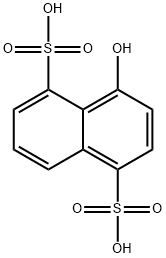4-hydroxynaphthalene-1,5-disulphonic acid
- CAS NO.:117-56-6
- Empirical Formula: C10H8O7S2
- Molecular Weight: 304.3
- MDL number: MFCD00035854
- EINECS: 204-197-6
- SAFETY DATA SHEET (SDS)
- Update Date: 2023-11-01 14:53:20

What is 4-hydroxynaphthalene-1,5-disulphonic acid?
Chemical properties
1-Hydroxynaphthalene-4,8-disulfonic acid [117-56-6]. (4-hydroxynaphthalene-1,5- disulfonicacid),Schollkopf ’s acid, deltaacid, oxy Chicago acid, C10H8O7S2, Mr 304.3: the sodium saltis readily solubleinwater, butthe barium saltis only sparingly soluble.Cold5 % oleumdehydrates 1-Hydroxynaphthalene-4,8-disulfonic acid to the sultone, whereas with hot 25 % oleum it undergoes sulfonation to give 1-hydroxynaphthalene-2,4,8-trisulfonic acid. Amination (Bucherer) gives 1-aminonaphthalene-4,8-disulfonic acid and caustic fusion gives 1,8-dihydroxynaphthalene-4-sulfonic acid. Diazo coupling and nitrosation take place in the 2-position.
Production Methods
1-Hydroxynaphthalene-8-sulfonic acid-1,8-sultone is heated with sulfuric acid at 80 – 90℃. The reaction mixture is then quenched by pouring into concentrated brine, whereby the sodium salt of 82 crystallizes. After isolation, this intermediate is hydrolyzed by heating with aqueous sodium carbonate and the product is isolated as its sodium salt after cooling.
Properties of 4-hydroxynaphthalene-1,5-disulphonic acid
| Density | 1.816±0.06 g/cm3(Predicted) |
| pka | -0.42±0.40(Predicted) |
Safety information for 4-hydroxynaphthalene-1,5-disulphonic acid
Computed Descriptors for 4-hydroxynaphthalene-1,5-disulphonic acid
4-hydroxynaphthalene-1,5-disulphonic acid manufacturer
Prolife Bio Chemical Industries Pvt Ltd
New Products
Tert-butyl bis(2-chloroethyl)carbamate 4-Methylphenylacetic acid N-Boc-D-alaninol N-BOC-D/L-ALANINOL N-octanoyl benzotriazole 3-Morpholino-1-(4-nitrophenyl)-5,6-dihydropyridin- 2(1H)-one Furan-2,5-Dicarboxylic Acid DIETHYL AMINOMALONATE HYDROCHLORIDE 1,1’-CARBONYLDIIMIDAZOLE R-2-BENZYLOXY PROPIONIC ACID 1,1’-CARBONYLDI (1,2-4 TRIAZOLE) N-METHYL INDAZOLE-3-CARBOXYLIC ACID (2-Hydroxyphenyl)acetonitrile 4-Bromopyrazole 5-BROMO-2CYANO PYRIDINE 5,6-Dimethoxyindanone 5-broMo-2-chloro-N-cyclopentylpyriMidin-4-aMine 2-(Cyanocyclohexyl)acetic acid 4-methoxy-3,5-dinitropyridine 1-(4-(aminomethyl)benzyl)urea hydrochloride 2-aminopropyl benzoate hydrochloride diethyl 2-(2-((tertbutoxycarbonyl)amino) ethyl)malonate tert-butyl 4- (ureidomethyl)benzylcarbamate Ethyl-2-chloro((4-methoxyphenyl)hydrazono)acetateYou may like
-
 1-Naphthol-4,8-disulfonic acid 99%View Details
1-Naphthol-4,8-disulfonic acid 99%View Details -
 117-56-6 98%View Details
117-56-6 98%View Details
117-56-6 -
 1975-50-4 98%View Details
1975-50-4 98%View Details
1975-50-4 -
 2-HYDROXY BENZYL ALCOHOL 98%View Details
2-HYDROXY BENZYL ALCOHOL 98%View Details
90-01-7 -
 2-Chloro-1,3-Bis(Dimethylamino)Trimethinium Hexafluorophosphate 221615-75-4 98%View Details
2-Chloro-1,3-Bis(Dimethylamino)Trimethinium Hexafluorophosphate 221615-75-4 98%View Details
221615-75-4 -
 14714-50-2 (2-Hydroxyphenyl)acetonitrile 98+View Details
14714-50-2 (2-Hydroxyphenyl)acetonitrile 98+View Details
14714-50-2 -
 118753-70-1 98+View Details
118753-70-1 98+View Details
118753-70-1 -
 733039-20-8 5-broMo-2-chloro-N-cyclopentylpyriMidin-4-aMine 98+View Details
733039-20-8 5-broMo-2-chloro-N-cyclopentylpyriMidin-4-aMine 98+View Details
733039-20-8